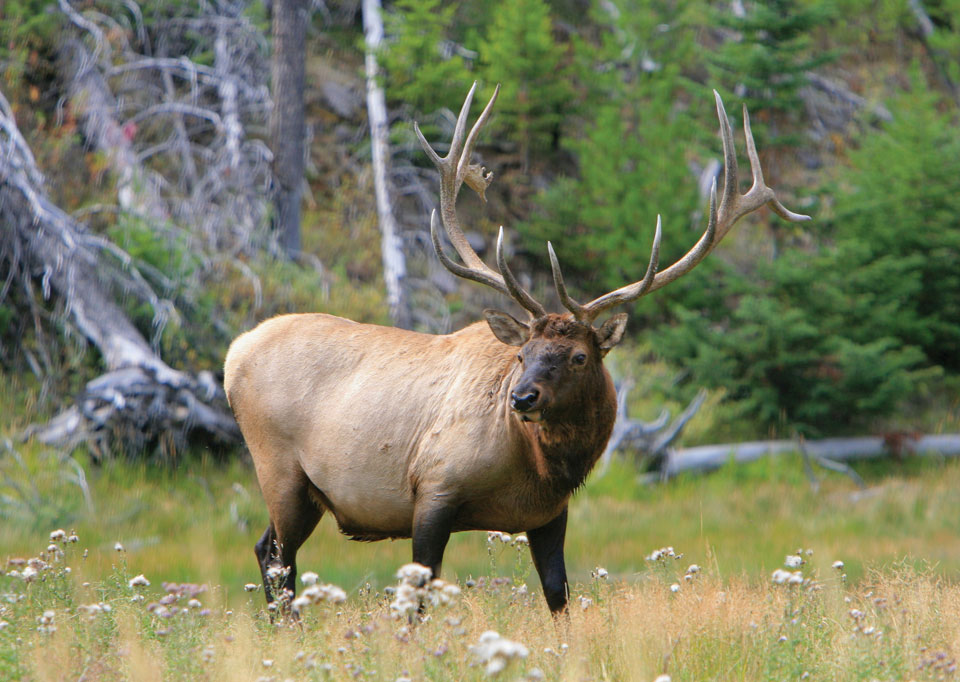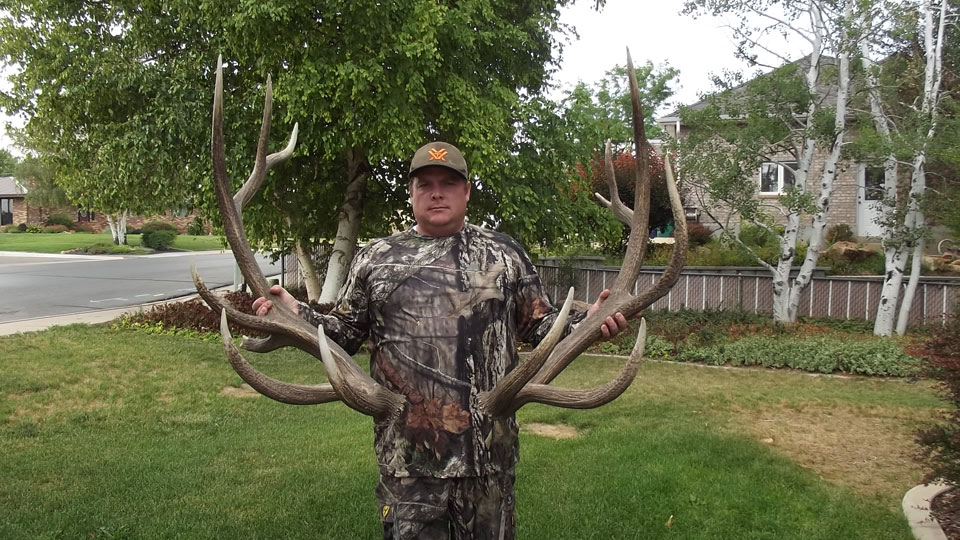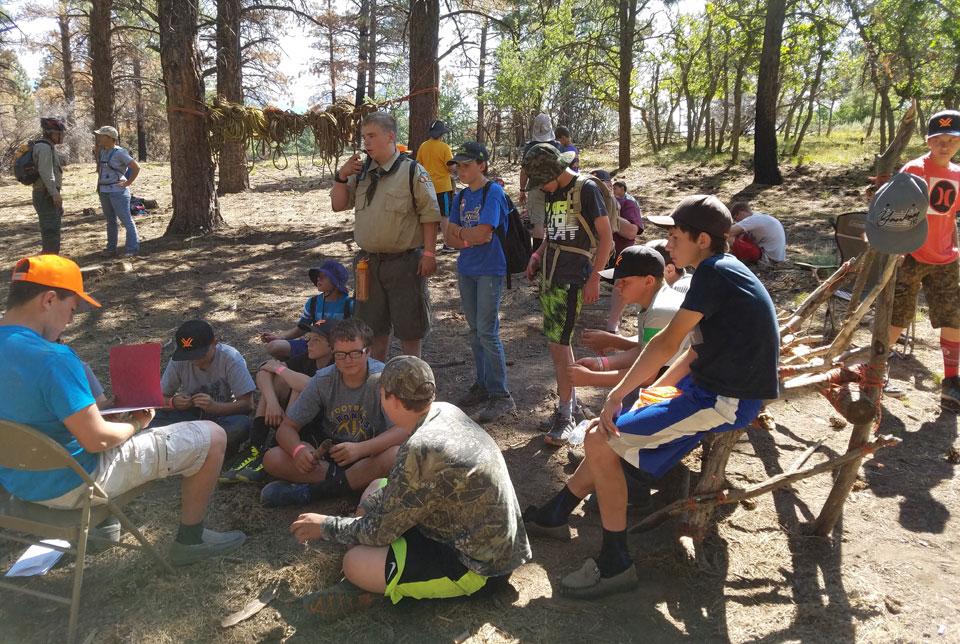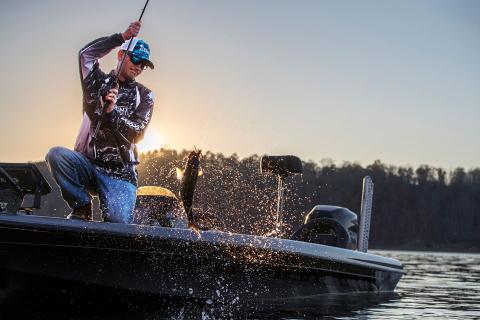Thirty-year-old Kyle Hosler of Blanding, Utah, has been a Mossy Oak ProStaffer for eight years and has been hunting elk since he was about five years old.

Since I was a little kid, I’ve gone out with my dad to look for elk, mule deer and shed antlers. I remember, when I was six years old, my dad took me out to a big meadow and told me to sit beside a specific big tree. He set up to start calling elk, and I waited not knowing what to expect. Dad bugled for some time and called in some bull and cow elk. Those elk walked to within 10-15 feet of me. My heart was racing like it was the lead car in last lap of the Indianapolis 500. Ever since that day, I’ve been totally fascinated with finding and calling elk. I’ve learned there’s nothing quite like being in the mountains and listening to elk bugle when they’re trying to locate cows. This episode happened before elk season started when we were trying to pinpoint elk. So, neither of us had a gun with us.
Elk Hunting Near Home
I hunt in the part of the Rocky Mountains known as the San Juans (or the Abajo Mountains locally referred to as the Blue Mountains or the Blues), mainly because they’re close to my house. We primarily hunt Forest Service, BLM (Bureau of Land Management) and other public lands and the San Juan - Elk Ridge Limited Entry Unit, up on top of those mountains. We have one of the best limited-entry units in the western U.S. here close to my home.
Each year that a hunter puts in to hunt this unit near my home and doesn’t receive a tag, he or she gets preference points. Right now I have 13 preference points for the limited-entry rifle tag, which means I’ve been putting in for this hunt for 13 years. Usually a hunter needs 20-25 preference points to get to hunt this limited-entry unit. Ten tags for this unit will go into the lottery system for the state that anyone can draw. Another 10 tags go to the hunters who have the most preference points for this unit. This unit is about 200-250 square miles, and the reason there’s so much demand for this unit is because the average-size bull elk taken here will score 300+ Boone and Crockett points. The number of tags for this unit varies each year, depending on how the elk herd is faring.
I put in for the prime rifle season each year that runs from mid to late September. A local outfitter who lives here in town generally has 100-150 trail cameras out on this unit hoping to locate these big bulls. The competition to identify where these big bulls are and then finding one is very competitive. That’s why local hunters near Elk Ridge have an advantage. These hunters know the general movement patterns of the elk herd on Elk Ridge. This year I think the general travel patterns of the Elk Ridge elk have changed because our region has had a couple of dry summers, and elk must have water.
I’ve learned that the best way to be competitive when elk hunting is to spend time in an area before elk season begins and use trail cameras to help you pinpoint elk. We also check historical travel corridors and the trail cameras out over springs in the mountains.
The hunting community here in Blanding is a tight-knit group. So, anyone who gets a tag to hunt the limited-entry hunts or has a friend who gets a tag to take a bull elk on Elk Ridge – we all usually band together and help that person or that person’s friend find and harvest a bull that’s 350+ points Boone & Crockett or better. On my last visit to this area, I checked seven trail cameras. I got pictures of a couple of spike bull elk and several bulls that would score to 330-340 points. Last year in this same general place, I found shed antlers of a bull elk that would have scored 398 points. 340 inches is probably the low side of the average bull elk taken at Elk Ridge. Last year a bull elk that scored 414 inches on Boone & Crockett was taken there.
We have numbers of big boy bulls running around at the San Juan - Elk Ridge Limited Access Area. Not only does the limited-entry status allow these bulls to grow to older-age classes, but also we’ve got a very good gene pool of big bulls that survive every year. Many of these bull elk have come into Utah from Colorado. I live about 1 hour, 15 minutes from the Colorado border. Many of these bigger bulls came from Colorado years ago and set-up residence on Elk Ridge. The state also transplanted a number of big bull elk into this region long before I was born. So, Elk Ridge offers a great gene pool of big, older bulls that have been passed down to the bulls we have available today.
I grew up in Blanding and spent a lot of time in these mountains when I was younger. Here on the San Juan Mountains, there’s a dividing line. West of these mountains the land goes out to Lake Powell, and that area is considered the limited-entry area. East of that line is considered the San Juan area. My grandpa has a small ranch of about 40 acres up there, and that region also homes a lot of BLM property around his ranch, as well as Church of Jesus Christ of Latter-day Saints’ land that I once hunted. You can draw a tag for any bull elk on the public lands near the property my grandpa owns. So, we can hunt that public land and my grandpa’s property for bull elk.
A Long-Shot Bull Elk with my .30/06

The best bull elk I’ve ever taken during the any-bull season scored 332 points. The rack is still down at my grandpa’s. My dad and I had put out trail cameras on my grandpa’s ranch, and the only bulls we got pictures of were raghorn bulls (small bulls) and cow elk. On the last day of this hunt, I had an opportunity to take a bull of a lifetime. I was only 16 years old.
A section of BLM land was located south of my grandpa’s property. I had trail cameras set up on my grandpa’s ranch and also on that BLM land. On the last day I could hunt on my tag, I went down to the nearby BLM land to check my trail cameras. I didn’t hold out much hope for this spot, because I had never seen any elk sign there. We had put out a salt lick and had two big rainstorms that had helped to fill up my grandpa’s pond. So, lots of vegetation had sprung up around the pond after the rains. I knew a group of elk made a circle and came by my grandpa’s pond every several days.
My dad and I went up to the top of a canyon that overlooked my grandpa’s farm. The elk usually went to the top of this canyon and worked their way down to various plateaus and flats. So, at the end of every hunt we had at my grandpa’s, we’d try to go to the top of that canyon and kick some rocks off the side of the canyon to sound like an elk walking and hopefully spook a bull elk out of that deep canyon. Then we’d throw out some bugles to see if we could get a bull to answer us.
We were scanning the region with our binoculars but didn’t see any elk this time. I pulled my bugle out and decided to bugle one time before walking back to the truck. I spotted this big bull walking out at about 230-yards away. I laid down my backpack, took a rest on it and told my dad I was planning to shoot. Before my dad could say anything, I squeezed the trigger on my .30/06.
Although my dad is a big fan of the .308 caliber rifle, I’d always told my dad I wanted to get a rifle with more knock-down power than the .308. Really, the .308 was a military round. I’d always wanted a .30/06. Once I finished my work for my Eagle Scout award, my dad asked me what I’d like to have as a present for that accomplishment. I told him I wanted a .30/06, and he bought me one. Every chance we had, my dad would go with me while I sighted it in, and I’d practice shooting that gun from 100-300 yards. My dad’s opinion was that if an elk was out more than 300 yards, then I didn’t need to try to shoot that elk any further than that.
When I realized this bull was at 320 yards, I still felt very comfortable taking the shot. I held the crosshairs somewhat high on the bull’s back. I’d done my homework on the ballistics’ tables of a .30/06. I knew about how much the bullet would drop at that distance. I aimed for the upper part of that bull’s back, and my bullet hit about six inches above his shoulder blade. I hit that bull solid the first time and put another bullet in him before he toppled off the edge of the canyon. My big bull rolled all the way down to the bottom of the canyon – about 150 yards through oak brush down to a creek. He’d been out on the edge of a ledge when I hit him. Once we finally got down to where the elk was laying, I was very surprised that he hadn’t broken or chipped any of his antlers in his fall.
When I finally reached my 342-inch bull elk at the bottom of the canyon he’d rolled down into, I knew that getting that big elk out of the canyon would be more work than my dad and I could do by ourselves. I called a couple of my buddies who were good hunters, gave them our location, told them about the huge elk I’d taken and asked if they’d come and help us. Once my friends arrived where we were, we field dressed and quartered my elk. We had about a 2-1/2 mile hike out of the canyon to get the meat and the elk’s head back to the truck. We all made two trips down the canyon and two trips out of the canyon – four hunters with frame packs – to get my big elk out of that deep canyon.
I’ve been asked, “Why didn’t you get that bull mounted?” I’d been saving my money for a mission trip for my church. Even a European elk mount was about $1,100. I didn’t want to take that much money out of my savings account for my mission trip. I just did a skull mount. My grandpa still has those antlers down at his store, since I took that huge bull elk on his land. Then when I was 19 years old I went on a Spanish-speaking mission trip to Malaga, Spain, and spent two years there. Once I returned home, I began my college career. That one bull elk is still the only bull I’ve ever taken.
Introducing Children to Elk Hunting

I’m the Boy Scout master of our local Boy Scout troop. We took about nine young Scouts to the top of the mountain at Elk Ridge to a lookout spot where we often see elk. I started calling, and we called in a bull that scored about 386 inches. He actually was harvested the fourth day of the limited-entry hunt and was officially measured; that’s why I knew exactly how much he scored. That bull came to us from about 550 yards away and came to within 160-170 yards of us. All the Boy Scouts got to see and hear him.
The wind was blowing so hard that the bull could hear us but couldn’t smell us. The wind was coming from behind the elk and blowing in our faces. We were able to keep the Boy Scouts quiet enough and still enough so that they could watch him come in to where we were. He had five cows with him that turned and went up the mountain in a different direction from where we were. When the big bull was at 160 yards, he stopped, stood still and looked around for about 10 minutes. The Scouts really appreciated him holding still for that 10 minutes. The gentleman who later took that huge bull was from Vernon, Utah, but I had some friends who were guiding him. They told me what the bull scored, and that bull was nicknamed Booner because of his very long main beams.
I have three children now, and when I find one of those big bulls and have a tag to allow me to harvest that animal, I’m looking forward to the day I can take them with me to hunt.
Need some big game recipe ideas? Get John and Denise Phillips’ free cookbook, “Miz Denise’s Outdoor Cooking: More Than 35 Recipes for Elk and Mule Deer.”



























